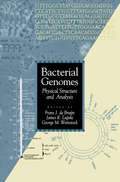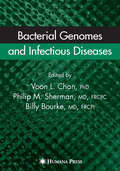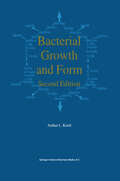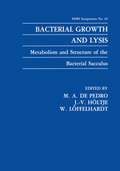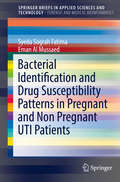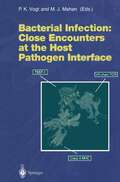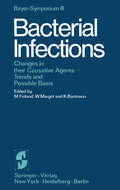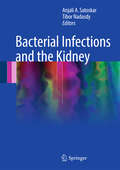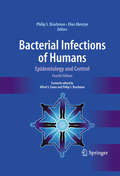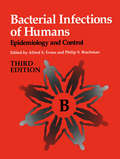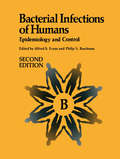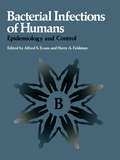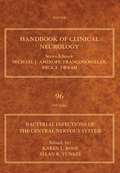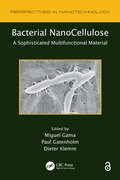- Table View
- List View
Bacterial Genomes: Physical Structure and Analysis
by Frans De Bruijn James R. Lupski G. M. WeinstockA wide range of microbiologists, molecular biologists, and molecular evolutionary biologists will find this new volume of singular interest. It summarizes the present knowledge about the structure and stability of microbial genomes, and reviews the techniques used to analyze and fingerprint them. Maps of approximately thirty important microbes, along with articles on the construction and relevant features of the maps are included. The volume is not intended as a complete compendium of all information on microbial genomes, but rather focuses on approaches, methods and good examples of the analysis of small genomes.
Bacterial Genomes and Infectious Diseases
by Ricky V. L Chan Philip M. Sherman Billy BourkeThe first bacterial genome, Haemophilus influenzae, was completely sequenced, annotated, and published in 1995. Today, more than 200 prokaryotic (archaeal and bacterial) genomes have been completed and over 500 prokaryotic genomes are in va- ous stages of completion. Seventeen eukaryotic genomes plus four eukaryotic chro- somes have been completed. The concept of achieving better understanding of an organism through knowledge of the complete genomic sequence was first demonstrated in 1978 when the first bacteriophage genome, X174, was sequenced. Complete genomic sequences of prokaryotes have led to a better understanding of the biology and evolution of the microbes, and, for pathogens, facilitated identification of new vaccine candidates, putative virulence genes, targets for antibiotics, new strategy for rapid diagnosis, and investigation of bacteria–host interactions and disease mec- nisms. Recent increased interest in microbial pathogens and infectious diseases is largely attributed to the re-emergence of infectious diseases like tuberculosis, emergence of new infectious diseases like AIDS and severe acute respiratory syndrome, the problem of an increasing rate of emergence of antibiotic-resistant variants of pathogens, and the fear of bioterrorism. Microbes are highly diverse and abundant in the biosphere. Less than 1% of these morphologically identified microbes can be cultured in vitro using standard techniques and conditions. With such abundance of microbes in nature, we can expect to see new variants and new species evolve and a small number will emerge as pathogens to humans.
Bacterial Growth and Form
by A.L. KochI assume that you already know a good deal of microbiology. In this book, I frequently use the word "we" by which I mean "you and I". Together we are going to consider bacteriology from a broader perspective and we will think our way through the important biological problems that are frequently just skipped over in every microbiology course. My most important reason for writing this book is to make accessible the relevant thinking from fields of science other than microbiology that are important to microbiology. The book is written for people that have already have a fascination with bacteria, but can see that their background for understanding is far complete. This book consists of topics that are largely omitted from microbiology textbooks and includes some mathematics, physics, chemistry, and evolutionary biology. It contains a good deal of my own work, both experimental and theoretical, together with a lot of speculation. If ten times bigger, it would be a full text book on microbial physiology. A third of the microbial physiology is covered by the recent is no longer treated even in textbook by White (2000). Another third current specialized tests and is greatly underrepresented in text books.
Bacterial Growth and Lysis: Metabolism and Structure of the Bacterial Sacculus (F.E.M.S. Symposium Series #65)
by M. A. De Pedro J. V. Höltje Wolfgang LöffelhardtThis volume is based on a FEMS Symposium entitled "Bacterial Growth and Lysis: Metabolism and Structure of the Bacterial Sacculus" held at the Monastery of Lluc (Mallorca, Spain) on 5-10 April, 1992. The goals of the symposium were to assess the present state of knowledge on the structure and physiology of the bacterial murein sacculus, and to develop new hypotheses and strategies to promote further development of the field. Consequently, the contributions compiled in this volume include broadly different approaches, from the introduction of new analytical methods to the presentation of provocative models for cell wall growth and division. Structural, biochemical, and genetic aspects are widely covered with special emphasis on the enzymology and regulation of murein hydrolases (autolysins). Comprehensive reviews on bacterial S layers and yeast cell walls are included to stimulate conceptual cross-feeding with these closely related topics. We believe that this book will provide the reader with a useful and up-to-date review of the topic. We would feel deeply rewarded by any positive influence this book may have on the future progress of the field, whereby all the scientific credit for it should be given to the authors of the excellent contributions presented.
Bacterial Identification and Drug Susceptibility Patterns in Pregnant and Non Pregnant UTI Patients (SpringerBriefs in Applied Sciences and Technology)
by Syeda Sograh Fatima Eman Al MussaedThis book provides a review of essential research on urinary tract infections (UTIs), as well as a broader perspective on methodologies adopted for the isolation and identification of the bacteria from urine samples of pregnant and non-pregnant women on the basis of their cultural, morphological and biochemical characteristics. The identification is extended to the strain level by means of molecular identification involving BLAST as a bioinformatics tool. The book also addresses the roles of various other bioinformatics tools for tracing the phylogenetic tree and conservation studies among the bacteriocin of the identified bacteria. Lastly, it assesses the antibiotics resistance patterns of these isolates.
Bacterial Infection: Close Encounters at the Host Pathogen Interface (Current Topics in Microbiology and Immunology #225)
by Peter K. Vogt Michael J. MahanWhen it comes to bacterial disease, we are living in a state of false security. Antibiotics have indeed brought unprecedented health benefits, protection from and cure of bacterial diseases during the past 50 years. But there are ominous signs that the fortress and the defenses built on antibiotics are crumbling. They are crum bling because we wittingly or unwittingly created selective con ditions for the emergence of superior pathogens that can no longer be controlled by antibiotics. There are numerous warnings. After a long period of eclipse tuberculosis has now emerged as a serious threat unchecked by antibiotic treatment. Recent years have seen reports of cholera epidemics, of anthrax infections, of serious problems with Salmonella and even with E. coli, just to name a few. Mankind is in a race with microbial invaders. The challenge is to anticipate and respond to developments that affect the precarious balance between man and microbe. This will re quire new knowledge and it will take time for an effective appli cation of that knowledge.
Bacterial Infections: Changes in their Causative Agents Trends and Possible Basis (Bayer-Symposium #3)
by M. Finland W. Marget K. BartmannBacterial Infections and the Kidney
by Anjali A. Satoskar Tibor NadasdyThis text is designed to present a comprehensive and state-of the-art but practical approach to the diagnosis and management of bacterial infection associated renal disease. The chapters address the different types of glomerular, tubulointerstitial and vascular diseases, associated with bacterial infections, describe diagnostic pitfalls, provide differential diagnosis and discuss treatment and management. Easy to follow diagnostic algorithms and tables are included for practical usefulness. The text provides a large number of color microphotographs, illustrations and each chapter refers to the most important up to date literature in the area. All chapters are written by experts in the field and will include the most up-to-date clinical information. A comprehensive but user friendly resource on renal complications of bacterial infection, such as this book, is overdue, particularly now in the era of staphylococcus epidemic and emerging new resistant bacterial strains. Bacterial Infections and the Kidney will be an important resource for pathologists, nephrologists, general internists, infectious disease specialists, and urologists. Transplant surgeons may find the chapter on transplant pyelonephritis very useful.
Bacterial Infections of Humans: Epidemiology and Control
by Elias Abrutyn Philip S. BrachmanIn Memoriam of Alfred S. Evans The third edition of Bacterial Infections of Humans is dedicated to Alfred Spring Evans, who died on January 21, 1996, 2 ½ years after a diagnosis of cancer. Al was the senior editor of this textbook, which he founded with Harry Feldman in 1982. Al was a clinician, epidemiologist, educator, ca- lyst for biomedical research, historian, author, speaker, seeker of the truth, sincere friend of students, sports enthusiast, traveler, and truly a man of all seasons. He was a devoted husband to Brigette Klug Evans, father of three children, and grandfather of four. Al was born in Buffalo, New York, on August 21, 1917, to Ellen Spring and John H. Evans, M. D. , one of the United States’s ?rst anesthesiologists and an early researcher in the ?eld of oxygen therapy. He received his undergraduate training at the University of Michigan; was awarded an M. D. degree in 1943 from the University of Buffalo; interned in Pittsburgh, Pe- sylvania; and performed his medical residency at the Goldwater Hospital in New York City. He was in the United States Army from 1944 to 1946, assigned as a public health of?cer to a base in Okinawa, Japan. It was there that he met Drs. Albert Sabin and John R. Paul, who came to Okinawa to test a new Japanese encepha- tis vaccine. Al was invited by Dr. Paul to come to Yale Alfred S.
Bacterial Infections of Humans: Epidemiology and Control
by Philip S. Brachman Alfred S. EvansIn Memoriam of Alfred S. Evans This third edition of Bacterial Infections of Humans is dedicated to Alfred Spring Evans, who died on January 21, 1996, 2Yz years after a diagnosis of cancer. Al was the senior editor of this textbook, which he founded with Harry Feldman in 1982. Al was a clinician, epidemiologist, educator, catalyst for biomedical research, historian, author, speaker, seeker of the truth, sincere friend of students, sports enthusiast, traveler, and truly a man of all seasons. He was a devoted husband to Brigette Klug Evans, father of three children, and grandfather of four. Al was born in Buffalo, New York, on August 21,1917, to Ellen Spring and John H. Evans, M.D., one ofthe United States's first anesthesiologists and an early researcher in the field of oxygen therapy. He received his undergraduate training at the University of Michigan; was awarded an M.D. degree in 1943 from the University of Buffalo; interned in Pittsburgh, Pennsylvania; and performed his medical residency at the Goldwater Hospital in New York City. He was in the United States Army from 1944 to 1946, assigned as a public health officer to a base in Okinawa, Japan. It was there that he met Drs.
Bacterial Infections of Humans: Epidemiology and Control (pdf)
by Philip S. Brachman Alfred S. EvansBacterial Infections of Humans: Epidemiology and Control
by Alfred S. Evans Harry A. FeldmanThis is a companion volume to Viral Infections of Humans: Epidemiology and Control. The apparent success of that book in bridging the gap between texts on basic microbiology and those on clinical infectious diseases led to editing this one on bacterial infections, the chapters of which are organized in exactly the same format of 12 units: introduction, historical background, methodology, biological characteristics of the organism, descriptive epidemiology, mechanisms and routes of transmission, pathogenesis and im munity, patterns of host response, control and prevention, unresolved problems, references, and suggested reading. The purpose of this book is to provide a description and understanding of the pathogenesis of infection and disease both within the community and within the individual. This is done in the belief that a variety of factors in both the external and the internal environment, and in the nature of the infectious agent, influence exposure, the development of infection, and the pattern of the host response. An understanding of the epidemiology and pathogenesis of these processes forms the basis for approaches to control and prevention. The first two chapters of this book deal with general epidemiological concepts and with surveillance.
Bacterial Infections of the Central Nervous System (ISSN #Volume 96)
by Karen L. Roos Allan R. TunkelBacterial Infections of the Central Nervous System aims to provide information useful to physicians taking care of patients with bacterial infections in the central nervous system (CNS), which can lead to morbidity and mortality. The increased number of patients suffering from this infection has led to the development of vaccines and antibiotics. Comprised of four chapters, the book explains the general approach to patients with bacterial CNS infection. It also discusses various CNS infection concepts and terms. These include the characteristic neuroimaging appearance of specific bacterial infections, the limitations of neuroimaging, the cerebrospinal fluid analysis, the pathogenesis and pathophysiology of bacterial CNS infections, the developments of specific adjunctive strategies, and the principles of antimicrobial therapy. It also includes discussions on various diseases that target the CNS, such as meningitis, focal CNS infections, neurological complications of endocarditis, suppurative venous sinus thrombosis, infections in the neurosurgical patient, and CNS diseases caused by selected infectious agents and toxins. This book will serve as a guide for clinical physicians who have patients suffering from bacterial CNS infection. Valuable insights into the pathophysiological mechanism of bacterial CNS infections A multidisciplinary reach that provides critical information for neurologists, neurosurgeons, and specialists in infectious disease Considerable information and emphasis on new diagnostic techniques and laboratory testing
Bacterial Invasion into Eukaryotic Cells: Subcellular Biochemistry (pdf) (Subcellular Biochemistry #33)
by Tobias A. Oelschlaeger Jörg H. HackerBacterial Invasiveness (Current Topics in Microbiology and Immunology #209)
by Virginia L. MillerIntracellular pathogens are responsible for a number of important diseases worldwide, including tuberculosis, plague and bacillary dysentery. This volume focusses on those intracellular pathogens that have been studied most extensively at the molecular, genetic, and cellular level. The reviews attempt to integrate the information derived from these diverse approaches into a cohesive picture. In recent years the entry steps have been described at the molecular and genetic level, and the important signal transduction events are being elucidated. It is now becoming clear that there are both similarities and differences both in terms of the steps involved and of the genetic basis of bacterial invasiveness. These reviews of the "state of the art" provide a foundation from which to proceed.
Bacterial Lipopolysaccharides: Structure, Chemical Synthesis, Biogenesis and Interaction with Host Cells
by Yuriy A. A. Knirel and Miguel A. A. ValvanoThe bacterial lipopolysaccharide also known as endotoxin is exhaustively covered in the present work. Central emphasis is placed upon the fine chemical structure of the lipopolysaccharide and its significance for understanding their activity and function. In particular, the role it plays in the interaction of bacteria with other biological systems is examined. New aspects of their physicochemical biology are introduced and updates to the current knowledge concerning the lipopolysaccharide are provided. This important class of biomolecules has recently attracted the attention of many investigators, in particular for understanding its involvement in innate immunity, toll-like receptor recognition and intracellular signaling.
Bacterial Metabolism (Springer Series in Microbiology)
by Gerhard GottschalkThis concise yet comprehensive text surveys the field of bacterial metabolism in terms useful to students and researchers. Emphasis is on those metabolic reactions occurring only in bacteria. Thus, the book describes in detail the energy metabolism of the various groups of bacteria. In addition, it examines pathways used by bacteria for the degradation of organic compounds, the synthesis of cellular constituents, the regulation of bacterial metabolism and the fixation of molecular nitrogen.
Bacterial Multidrug Exporters: Methods and Protocols (Methods in Molecular Biology #1700)
by Akihito Yamaguchi and Kunihiko NishinoThis detailed volume utilizes our current understanding of the structural basis of multidrug recognition and multidrug efflux mechanisms to provide protocols involving these vital intrinsic membrane proteins widely distributed in bacteria. Beginning with protocols for the structural analysis of bacterial multidrug exporters, the book continues with sections on biochemical and bioengineering analysis, computational analysis, biomedical approaches, as well as advanced technologies expected to be applied to multidrug efflux transport studies. Written in the highly successful Methods in Molecular Biology series format, chapters include introductions to their respective chapters, lists of the necessary materials and reagents, step-by-step, readily reproducible laboratory protocols, and tips on troubleshooting and avoiding known pitfalls. Authoritative and practical, Bacterial Multidrug Exporters: Methods and Protocols serves as an ideal guide to this fast moving field of study.
Bacterial NanoCellulose: A Sophisticated Multifunctional Material (Perspectives In Nanotechnology Ser. #9)
by Miguel GamaThe first book dedicated to the potential applications and unique properties of bacterial cellulose (BC), this seminal work covers the basic science, technology, and economic impact of this bulk chemical as well as the companies and patents that are driving the field. It reviews the biosynthesis and properties of BC, including genetics and characterization; discusses the advancing technology as it relates to product development, bioreactors, and production; and analyzes the economic impact of BC on a diverse range of industry applications, including materials and biomaterials, biological and polymer sciences, and electromechanical engineering.
Bacterial NanoCellulose: A Sophisticated Multifunctional Material
by Miguel Gama Paul Gatenholm Dieter KlemmeBacterial nanocellulose (BNC) is an emerging nanomaterial with unique properties produced by several species of ubiquitous fermentation bacteria, most importantly Gluconacetobacter xylinus, previously known as Acetobacter xylinum. BNC has been used for a variety of commercial applications including textiles, cosmetics, and food products, and it has
Bacterial Pathogenesis: Methods and Protocols (Methods in Molecular Biology #431)
by Frank R. DeLeo and Michael OttoBacterial infections affect world health today as a leading cause of morbidity and mortality. This book presents in-depth methods and state-of-the-art protocols for investigating specific mechanisms of pathogenesis for a wide range of bacteria. Written by experts in the field, this invaluable collection includes protocols to study host-pathogen interactions, animal models of infection, and novel approaches to identifying therapeutic targets designed to control infections.
Bacterial Pathogenesis: Methods and Protocols (Methods in Molecular Biology #2674)
by Pontus Nordenfelt Mattias CollinThis detailed volume presents a diverse set of methodological approaches designed to improve our understanding of bacterial infections from a wide range of bacterial species. Beginning with biofilms and subcellular compartments, the book explores transcriptional analysis, methods for studying plasmid dynamics, and tools for phylogenetic analysis of bacterial genomes, as well as bacterial effector proteins interfering with host systems, host response analysis, and in vivo and in vitro infection models. Written for the highly successful Methods in Molecular Biology series, chapters include introductions to their respective topics, lists of the necessary materials and reagents, step-by-step and readily reproducible laboratory protocols, and tips on troubleshooting and avoiding known pitfalls. Authoritative and up-to-date, Bacterial Pathogenesis: Methods and Protocols, Second Edition is a vital resource for researchers in the area of infection biology, as well as but not limited to, those working in the fields of microbiology, immunology, structural biology, molecular biology, genetics, imaging, and computational study.
Bacterial Pathogenesis: A Molecular Approach (ASM Books)
by Brenda A. Wilson Malcolm Winkler Brian T. HoThis highly anticipated update of the acclaimed textbook draws on the latest research to give students the knowledge and tools to explore the mechanisms by which bacterial pathogens cause infections in humans and animals. Written in an approachable and engaging style, the book uses illustrative examples and thought-provoking exercises to inspire students with the potential excitement and fun of scientific discovery. Completely revised and updated, and for the first time in stunning full-color, Bacterial Pathogenesis: A Molecular Approach, Fourth Edition, builds on the core principles and foundations of its predecessors while expanding into new concepts, key findings, and cutting-edge research, including new developments in the areas of the microbiome and CRISPR as well as the growing challenges of antimicrobial resistance. All-new detailed illustrations help students clearly understand important concepts and mechanisms of the complex interplay between bacterial pathogens and their hosts. Study questions at the end of each chapter challenge students to delve more deeply into the topics covered, and hone their skills in reading, interpreting, and analyzing data, as well as devising their own experiments. A detailed glossary defines and expands on key terms highlighted throughout the book. Written for advanced undergraduate, graduate, and professional students in microbiology, bacteriology, and pathogenesis, this text is a must-have for anyone looking for a greater understanding of virulence mechanisms across the breadth of bacterial pathogens.
Bacterial Pathogenesis: A Molecular Approach (ASM Books)
by Brenda A. Wilson Malcolm Winkler Brian T. HoThis highly anticipated update of the acclaimed textbook draws on the latest research to give students the knowledge and tools to explore the mechanisms by which bacterial pathogens cause infections in humans and animals. Written in an approachable and engaging style, the book uses illustrative examples and thought-provoking exercises to inspire students with the potential excitement and fun of scientific discovery. Completely revised and updated, and for the first time in stunning full-color, Bacterial Pathogenesis: A Molecular Approach, Fourth Edition, builds on the core principles and foundations of its predecessors while expanding into new concepts, key findings, and cutting-edge research, including new developments in the areas of the microbiome and CRISPR as well as the growing challenges of antimicrobial resistance. All-new detailed illustrations help students clearly understand important concepts and mechanisms of the complex interplay between bacterial pathogens and their hosts. Study questions at the end of each chapter challenge students to delve more deeply into the topics covered, and hone their skills in reading, interpreting, and analyzing data, as well as devising their own experiments. A detailed glossary defines and expands on key terms highlighted throughout the book. Written for advanced undergraduate, graduate, and professional students in microbiology, bacteriology, and pathogenesis, this text is a must-have for anyone looking for a greater understanding of virulence mechanisms across the breadth of bacterial pathogens.
Bacterial Pathogenesis of Plants and Animals: Molecular and Cellular Mechanisms (Current Topics in Microbiology and Immunology #192)
by Jeffrey L. DanglThe last decade has seen an explosion in our understanding of how bacterial pathogens trick, cajole, usurp and parasitize their various hosts. This renaissance is due to the convergence of molecular and cellular techniques with the power of microbial genetics. The purpose of this volume is to introduce recent advances in understanding selected systems chosen from both plant and animal hosts of bacterial pathogens. This somewhat nonobvious choice of topics was spurred by the recent findings, detailed by several conributors to this volume, of common systems used to secrete virulence factors from pathogens of both plants and animals. These serendipitous findings underscored the importance of basic research approaches to parallel problems in biology. More importantly, they brought together investigators who may not have otherwise become conversant with each other's experimental systems. I, for one, find the kinds of synergism reflected in a volume of this sort to be one of the most pleasant aspects of science and hope that the reader, whether a newcomer to the field or an expert, can find a new slant to old problems in the reviews contained h,E:lre. It was, however, necessary to limit volume length, and this has forced the exclusion of a number of fascinating bacterial pathosystems.
